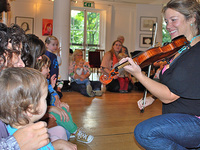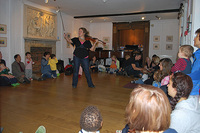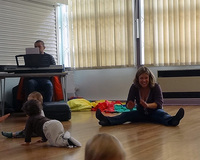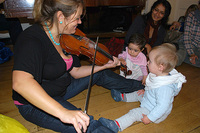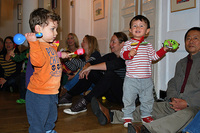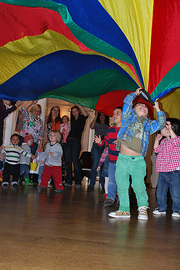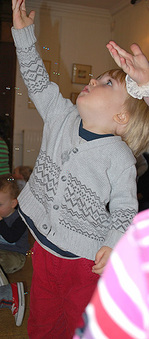English


Mini Mozart is a popular music class in London that babies can attend from the first year of their life. It offers children live music, including songs and instrumental music, played by professional musicians. How do babies experience music for the first time in the class? What is the benefit to babies of having a live music class?
- Name:
- Mini Mozart
- Target:
- Babies class (newborn-15 months old) / Toddlers class (15months- 3 years old) / Siblings class (newborn-4 years old)
- Time:
- 45 minutes in the morning on weekdays, weekly
- Venues:
- 12 venues in London (Crouch End/ Finchley/ Hampstead/ Highgate Pond Square Chapel/ Highgate Lauderdale House/ Islington/ Maida Vale/ Muswell Hill/ Notting Hill/ St Johns Wood/ Winchmore Hill/ Swiss Cottage)
- URL:
- http://www.minimozart.com/
When can babies attend a music class for the first time? In fact, music classes are one of the first classes which you can attend with your babies from the very early days, before they learn to control their body or speak any words. There are a lot of groups for babies where they sing nursery rhymes, for example in local play groups, libraries, and music classes. However, there are not many places that offer a music programme devised to lay the foundations for a lifelong music education, not only to enjoy singing songs.
New mothers can bring their babies to Mini Mozart whenever they feel ready to have a social life with them. There are twelve venues in London, which provide Babies classes for newborns up to about 15 months old, Toddlers classes for those aged from 15 months up to 3 years old, and Siblings classes which is a mixed age group, from 0-4 years old.
About 27 classes run every week, each of which has about 17-18 children, so around 460 children attend the classes each term. They are so popular that some of the classes have a waiting list. The big difference between Mini Mozart and many other music classes is that at least two professional musicians attend the class, providing a live music programme devised in terms of early years music education. Let's take a look at a 45- minute Babies class.
There are musicians at all Mini Mozart classes playing instruments such as the French horn, oboe, saxophone, cello, bassoon, trombone, guitar, and an African instrument called a Kora. The musicians lead the class through singing, playing the instruments, doing musical exercises, and telling stories, and the pianist accompanies them on the piano or keyboard.
I attended one of the classes in my local community centre with my baby. Mini Mozart classes take place in local places such as community centres and churches. Through the entrance packed with pushchairs, I saw mothers and nannies sitting on the floor with their babies in a circle, chatting. The Babies class is for babies from newborn to about 15 months old, so it was a mixture of those who were still in their mother's arms, to those who had just learnt to sit by themselves, and others who could crawl to the other side of the circle. For most of them, it was their first experience of attending a baby class, and as many came from a walking distance, it provided new mothers with opportunities to meet other local mothers with similar aged babies.
One day, as the regular teacher who played clarinet and flute was absent, Clare Louise-Shaw, the founder and the manager of Mini Mozart, showed up with her violin as a teacher for the day, along with a pianist. First, they sang 'One, two, three, wave hello to me...' to each other waving their hands. Even at this stage, they didn't wave their hands randomly, but clearly waved side to side in time with the music like a pendulum on a clock. When singing, 'sing it higher...', they waved their hands high up in the air accompanied by a high tinkling sound on the piano; and with 'sing it lower...', they waved their hands down to the floor with a low rumbling sound, in order to consciously synchronize the rhythm and high-low pitch of the sound to their body movement.
'Well, we've said hello to each other, now we have to say hello to the instrument!' Clare said, introducing her violin to the babies, singing, 'Hello, violin. Hello, piano.' She played a couple of short tunes on the violin, then the babies who were looking in all different directions suddenly gazed in the direction from where the sound was coming, and followed the dynamic movement of the bow on the violin. So, Clare walked slowly in front of every baby playing the violin, crouching, so that they could see the instrument well. Some babies tried to touch it when it came near them, then she plucked the very string which they tried to touch.
The first part of the class started with some warm-up musical exercises. For example, the participants did 'call and response', which is singing back the tune sung by the teacher, phrase by phrase, or shaking maracas in time to the rhythm of the song and the piano, and stopping when the music stops. All are intended to let them learn basic rhythm, phrases and tempo through playing musical games. The other exercise was to sing from lower C to upper C, singing, 'On my feet is a little flea, now it's climbing up my knee, past my tummy past my nose, on my head where my hair grows', while touching their toes with their fingers crawling up to their head and then down to the toe again.
Clare explained, 'The idea is that the babies hear the notes coming up with touching different part of their body from lower to higher, and as each note gets higher and higher, they understand the step-by-step nature of the scale.
'Warm-up is the bit where we try to steer the sense of pitch, rhythm and the idea of "call and response". So that is the more academic part of the class. It's also when the babies are more receptive because it's the beginning of the class. We do echo songs where they sing back the song phrase by phrase; and with the babies who cannot sing yet, it is the adults who actually sing, but it helps the adults to realize that this is the place where you, the adults, interact with their babies through music, and the musicians are here to facilitate that as the teacher. It gets the babies excited when they hear their own adult sing confidently. They get to see this "call and response", musical give and take, which is so important in classical music'.
The main part of the class is a mini-musical which changes every week. The teacher tells a well-known fairy tale while walking among the children using props and telling jokes, and sings well-known nursery rhymes that go along the story. One week, it was the tale of 'Little Red Riding Hood'. When Little Red Riding Hood went to see her grandmother, she took a bus as they sang one of the children's favourite songs, 'The Wheels On The Bus', and rowed a boat across the river singing, 'Row, Row, Row Your Boat', and looked up the sky and sang 'Twinkle, Twinkle, Little Star'. Like this, the teacher made some changes to the story so that she could include many songs along the way. Once the participants learnt the system, they got excited to know what to expect next: when the girl asked the wolf who disguised himself as her grandmother, 'Why is your head so big? Why are your shoulders, knees and toes so big?' they could expect that they were about to sing a song called 'Head, Shoulders, Knees and Toes'.
There are about twenty versions of musicals, each of which includes about eight songs. They rotate about sixty songs each term, and some of them are used repeatedly, because some songs are especially fond of by children, and when they are skipped, people would ask 'Why didn't you do that today? Can we sing it next week?' It also helps new mothers and mothers from abroad, who don't know English nursery rhymes except for 'Twinkle Twinkle Little Star', because they can learn new songs every time and remember popular nursery rhymes by singing them over and over again.
Like Japanese Te-asobi-uta, they sing songs while rocking, jumping, clapping and moving their bodies to the music, so the babies not only listen to the music through their ears, but also feel the movement of the music through their body. Even a baby of a few months old remembers the music and movement, and starts to show excitement, waiting to clap their hands or jump in the air by the end of the term. They might be very young but they can still link their ears, body and brain by repeating the same repertoire and expecting what is coming next.
Near the end of the story, Clare took out a large parachute, and everyone grabbed and moved it up and down in time to the piano music. When the pianist played slow and quiet music, they moved it slowly, and when the tune suddenly changed to a fast and cheerful one, they also changed the way they shook it. The children could move it themselves, or watch it move from underneath. The dynamic movement of a big and colorful parachute made it easier for children to recognize the character of the music. The teacher didn't use words such as 'Fast!' to conduct the movement, and the pianist changed music with lots of different characters without any notice, so the participants had to listen to the music carefully, which made the game more interesting.
When the teacher blew bubbles at the end of the class, the children started to follow the bubbles floating slowly to the piano music, and enjoyed moving around trying to catch them. After having fun with music, they said good bye to the instruments, waving their hands and singing, 'Bye-bye, violin. Bye-bye, piano', and then waved good-bye to their friends.
The 45 minutes filled with enjoyable activities coming one after another conveyed some important factors and joy of music to the children, through the activities and the way the music was played, without explaining them in words. In the next report, I will introduce the background and philosophy of Mini Mozart, through an interview with Clare, the founder.
Report: Chigusa Futako

